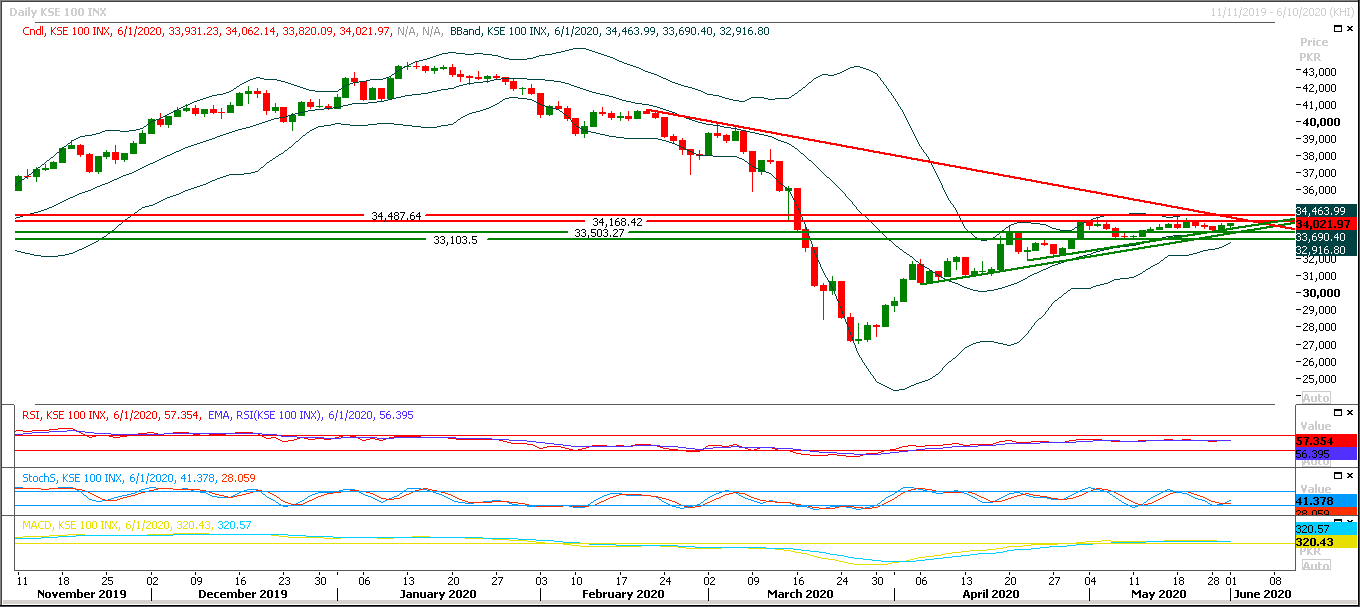Technical Overview
The Benchmark KSE 100 index is being caged inside a triangle below its 50% correction of its last bearish rally on daily chart. As of now it's expected that index would face major resistant at 34,300pts initially and then 34,500pts would as a pivotal value which would try to cap current bullish sentiment. Therefore its recommended to post trailing stop loss on resisting long positions. While on the other side selling on strength between 34,300 and 34,500pts would be beneficial. While on flip side in case of rejection on its resistant region index would sliding downward and would try to find some ground initially at 33,860pts and then 33,500pts.Alternatively swing trading could be beneficial between 33,500pts and 34,500pts. On short term basis index would remain range bound until it would not succeed either in closing above 35,200pts or 32,500pts.

Regional Markets
Stocks under pressure as Trump vows to end violent protests
Asian stocks were set to come under pressure on Tuesday following a dip in Wall Street futures as U.S. President Donald Trump vowed to use force to end violent protests in American cities, souring a previously upbeat market mood. E-mini futures for the S&P 500 fell 0.38% and Japan’s Nikkei 225 futures lost 0.34%. Australian S&P/ASX 200 futures rose 0.15% in early trading. The early indications came after major U.S. stock indexes closed with gains of about 0.5% and continued to hover near three-month highs. As Asian markets prepared to open, dozens of cities across the United States were under curfews with the National Guard deployed in 23 states and Washington, D.C. The curfews followed protests over the death of George Floyd, a 46-year-old African American who died in Minneapolis after being pinned beneath a white police officer’s knee for nearly nine minutes. The dollar index fell 0.4%, as risk appetite had increased on optimism that the worst of the global economic downturn caused by the coronavirus may be in the past.
Read More...
Business News
Rupee slips Rs3.18 in three sessions
US dollar has recorded consecutive gains against the rupee in the last three sessions reflecting the demand and supply imbalances. Globally, the US dollar has fallen against pound and euro during the last week indicating the pressure on US economy that is facing high unemployment, low consumption and now riots in more than 20 cities. Currency dealers said the dollar’s closing price on Monday was Rs164.08, up 98 paisa. Moreover, bankers said the demand has been increasing slowly but the sudden rise in dollar was mostly speculative.
Read More...
Pandemic’s effect on food security to be reviewed
With major real sectors of economy in the red, the government has called the first meeting of the Think Tank on Economic Impact of Covid-19 on Wednesday (June 3) to review and analyse the food security situation and ponder over possible responses. The Think Tank on Economic Impact of Covid-19 was constituted by Prime Minister Imran Khan on May 5. It has been entrusted with to focus on four key areas at the outset before moving to the long-term goals given the fact that the agriculture sector missed its output targets by big margins, it was the only sector that in fact posted a growth compared to contraction in industrial and services sectors.
Read More...
Rains to aggravate locust swarms: Food and Agriculture Organisation
The number of locusts could grow twenty-fold in the coming rainy season in South Asia unless extra measures to counter the swarms are put in place the Food and Agriculture Organisation (FAO) of the United Nations has warned. According to FAO experts, a single swarm of desert locust can cover an entire square kilometre and contain some 80 million insects. Swarms of desert locust, which originated in Africa, have moved swiftly into West Asia, attacking vegetation in parts of Iran and Pakistan and are now threatening crops in India. These swarms are the worst experienced in more than a generation, experts say.
Read More...
Pakistan's inflation rate slows to 8.2pc year-on-year in May
The Consumer Price Index (CPI) inflation rate slowed to 8.2 per cent year-on-year in May, the Pakistan Bureau of Statistics (PBS) said on Monday. The inflation rate was 8.5pc in April, and currently stands at 10.94pc for the period from July to May, 2019-20. CPI peaked in January, registering 14.56pc year-on-year. Food inflation, with a weight of 34.5pc in the overall number, was 12.24pc year-on-year for May, while transport inflation was recorded at -7.46pc for the same period. Petroleum prices have fallen drastically in Pakistan over the last few weeks, in line with global prices.
Read More...


0 Comments
No comments yet. Be the first to comment!
Please log in to leave a comment.